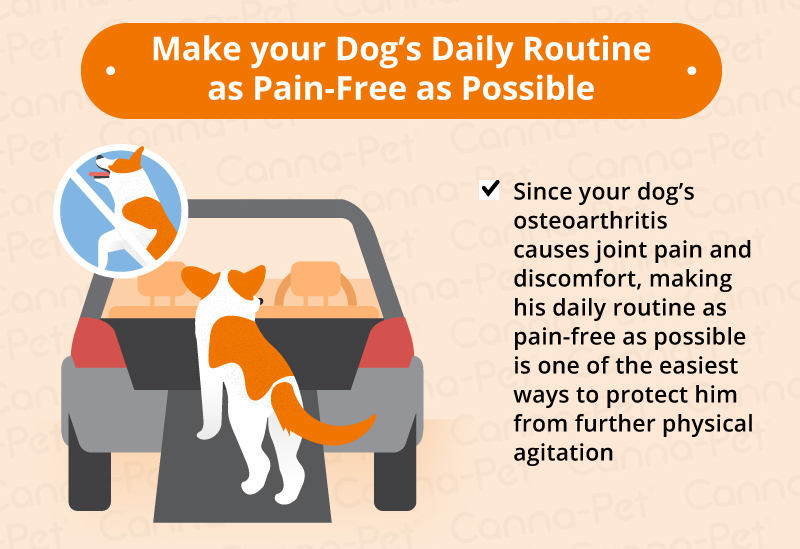Osteoarthritis, also referred to as OA and degenerative joint disease (DJD), is by definition the progressive and permanent deterioration of the cartilage surrounding the body’s joints.
While arthritis is a general medical term describing inflammation of the joints, osteoarthritis is the terminology used when referring to a form of chronic joint inflammation directly caused by the deterioration of joint cartilage. Statistically speaking, geriatric dogs are at the highest risk for the disease.
Due to the introduction of a variety of new treatments and supplements, medical treatment of osteoarthritis has vastly improved over the past few years. Unfortunately, because osteoarthritis and other forms of degenerative bone diseases such as hip dysplasia are primarily genetic or inherited conditions, there are no preventative measures you can take to protect your four-legged friend.
However, by monitoring your dog’s diet and exercise regimen and incorporating supplements with anti-inflammatory qualities into his daily routine, you may be able to ensure his quality of life and lessen the severity of his symptoms. By taking a proactive part in your dog’s osteoarthritis care, you can help decrease the progression of the disease while managing his overall level of comfort.
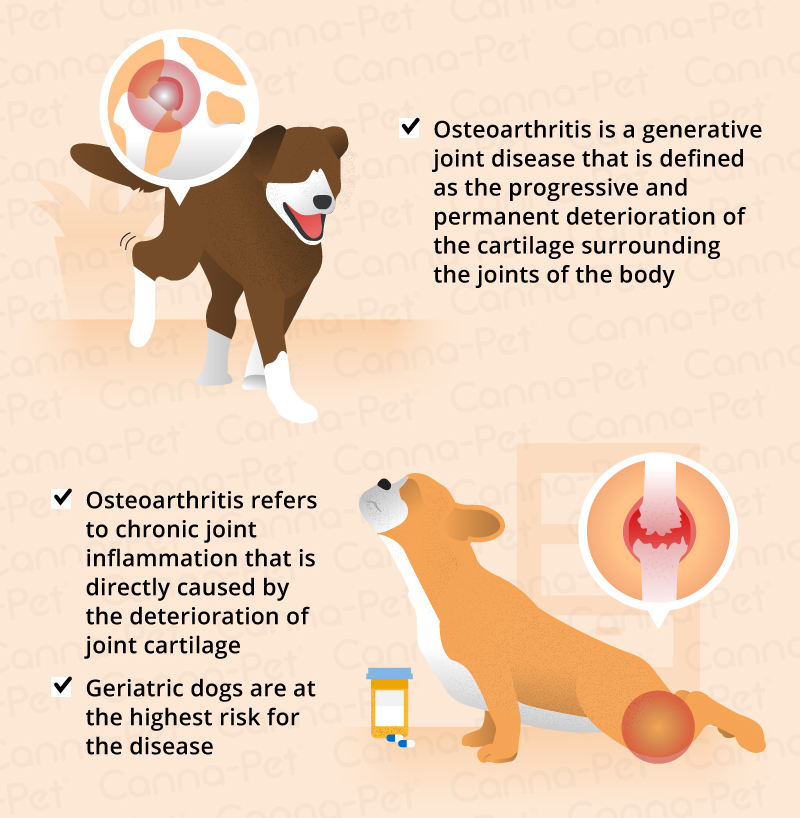
Signs & Symptoms of Osteoarthritis in Dogs
Although osteoarthritis (OA) is fairly common in dogs, it is nonetheless distressing for both you and your beloved pet. Depending on the severity of your pooch’s condition, symptoms may be barely detectable to debilitating. Therefore, it’s important to pay close attention to your dog’s overall health, especially as he ages.
If you notice the following signs and symptoms associated with osteoarthritis, you may want to consult with your veterinarian for a complete physical and treatment regimen:
- A noticeable decrease in activity
- Stiffness, limping, or favoring a limb
- Inability to rise or get up with ease, particularly after sleep or resting
- Reluctance to walk, jump, play, climb stairs etc.
- Shows signs of pain or soreness (winces when touched; irritability; fatigue, etc.)
- Partial or complete lameness/inability to walk
- Lagging behind on walks
- Whimpering or yelping in pain
- Acting aggressive or withdrawn
- Displaying other changes in behavior or disposition
Largely dependent upon your dog’s specific breed, joint disease may occur in the earlier or latter stages of his/her lifespan. Larger breeds are more susceptible to different forms of skeletal disease than smaller dogs.
Inherited conditions such as hip dysplasia are commonly seen in German Shepherds, Golden Retrievers, Labrador Retrievers, Staffordshire Terriers, Alaskan Malamutes, Samoyeds, Old English Sheepdogs, Rottweilers, and Saint Bernards. Smaller breeds who suffer from hip dysplasia include Pugs and French Bulldogs.
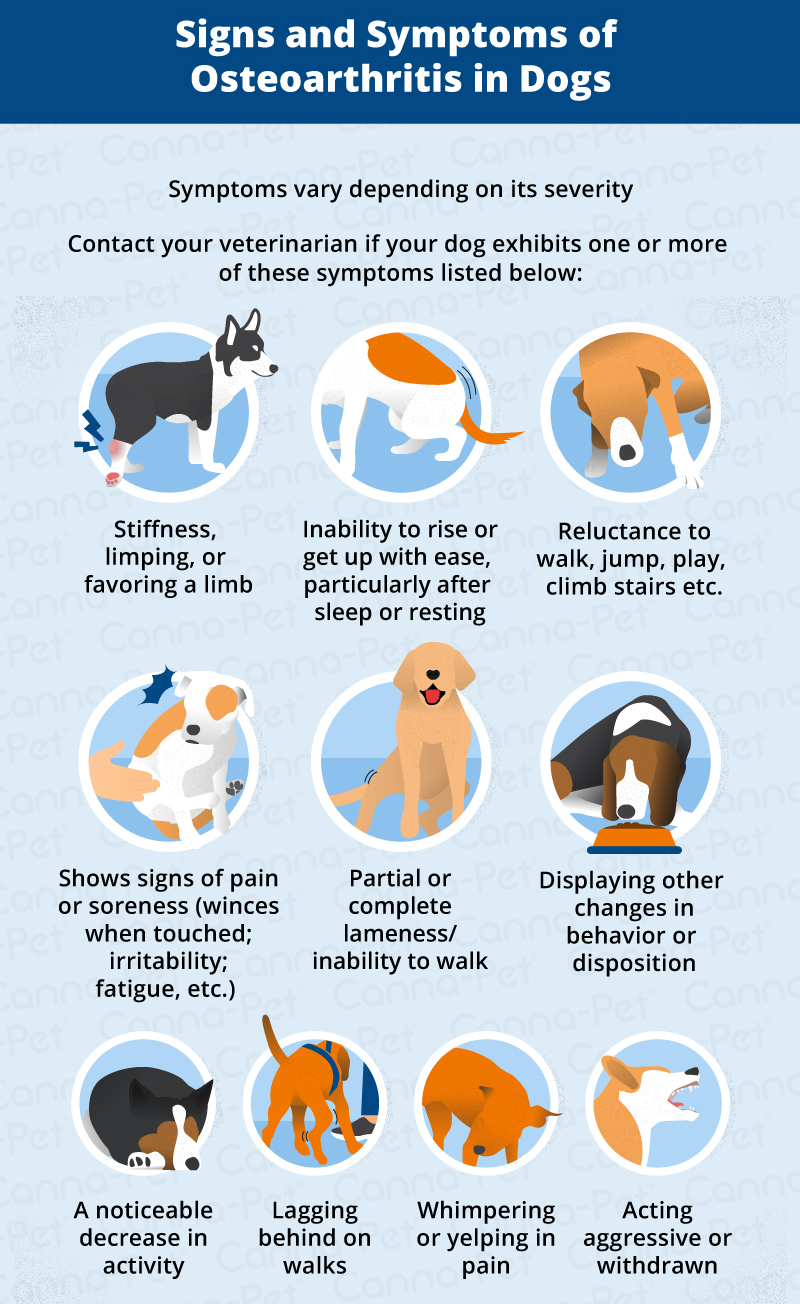
Managing Canine Osteoarthritis
With the advent of advanced medical developments over the last several decades, treatment for dog osteoarthritis has improved a great deal. However, because such conditions are inherited, there is no prevention or cure available.
Although there have been a number of products (including supplements and drugs) to ease your dog’s symptoms and slow the progression of the disease, there isn’t any way to reverse the physical changes, such as looseness found in joints, bone/cartilage loss or deterioration, and other related symptoms.
Therefore, the primary goal when administering osteoarthritic care to your dog is to focus on pain management: once clinical signs have been diagnosed, you and your veterinarian may discuss a variety of options to make your dog as comfortable as possible.
Since surgeries are cost-prohibitive for most people, medical management is usually the only realistic path for pet owners. Whether your pet’s a young pup displaying early OA symptoms or a geriatric pooch suffering from chronic osteoarthritis, it’s important to develop a medical management routine specifically suited to your dog’s needs and condition.
Because medical management is a multifaceted approach, it’s best to consult with your vet to determine a course of action. Typically, he or she will most likely use a combination of modalities to treat your pet, including the following:
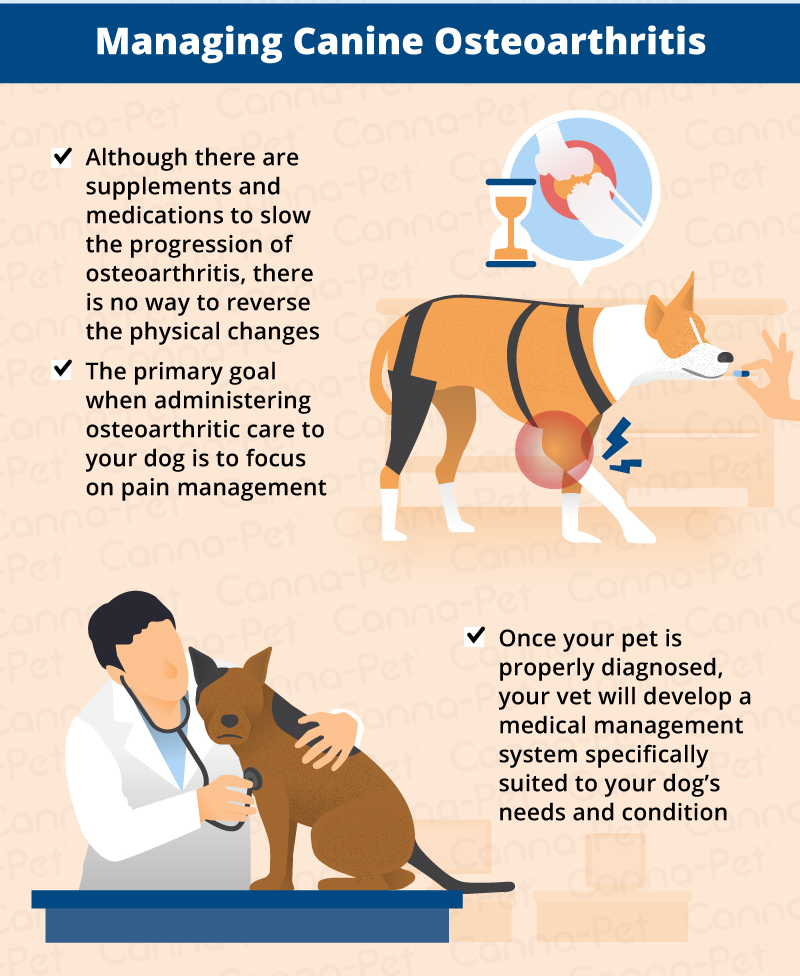
Following A Diet & Weight Management Plan
Following your veterinarian’s guidance, formulating a weight management routine is essential to the health of any dog with osteoarthritis, particularly for those who are clinically obese. With statistics reporting 50% of pets in the U.S. as overweight, it’s crucial to address your dog’s eating habits and establish a diet that ensures your pooch’s optimal weight and health.
The less weight your dog carries, the less stress he’ll be putting on his delicate skeletal system. By helping your dog lose the necessary pounds (and subsequently maintaining his ideal weight), you can maintain his quality of life while reducing the pain and discomfort associated with dog osteoarthritis.
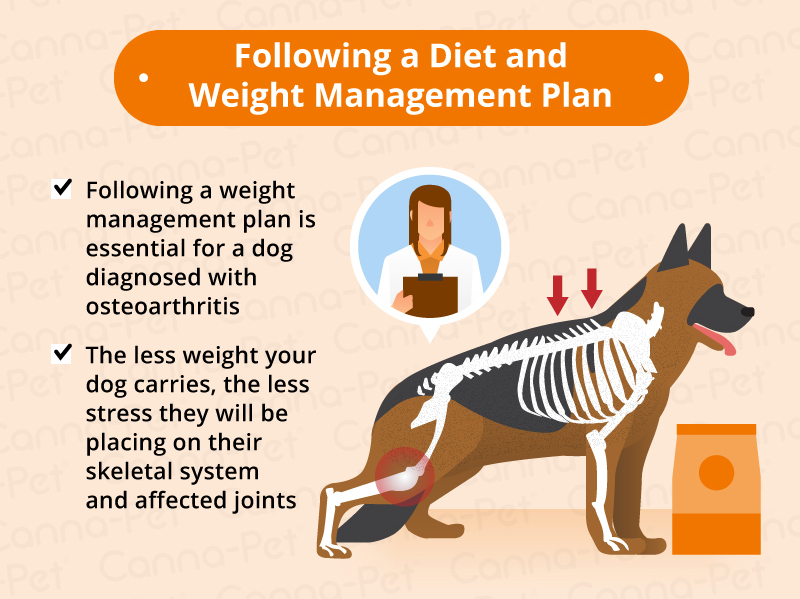
Creating an Exercise Routine
One of the next important steps in any canine osteoarthritis healthcare plan is establishing a daily exercise routine for your dog. Depending on the severity of your dog’s condition, his age and overall health, your vet should be able to make physical activity suggestions suitable for your pooch.
A general rule of thumb includes low-impact exercises such as walking, swimming, and going up and down stairs. It’s important to be mindful of overly-rigorous activities, which may put undue stress on your dog’s joints.
Your dog will receive the most benefits from a daily routine – regular exercise can actually improve his muscle tone and range of motion while preventing lapses in mobility. You may wish to consult a CCRP (Certified Canine Rehabilitation Practitioner) for assistance when designating a suitable exercise plan for your pooch.
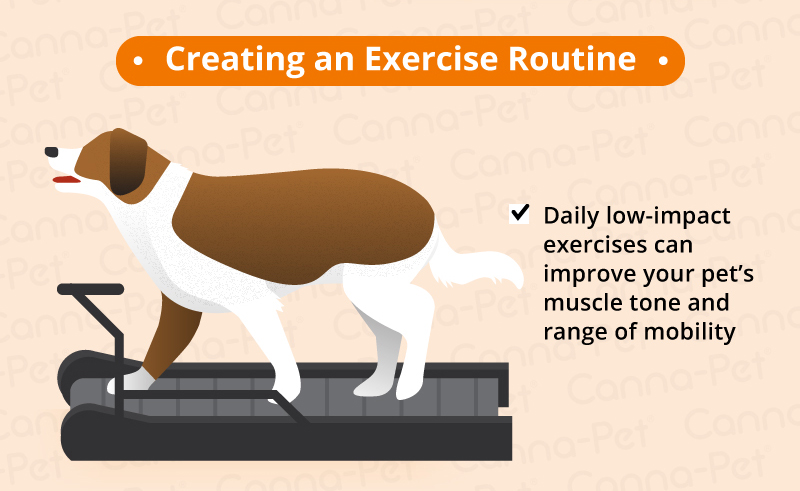
Providing A Warm Environment & Comfortable Sleep Area
Just as humans’ arthritis symptoms flare up in cases of extreme cold or damp, dogs also experience similar discomfort. Keeping that in mind, creating a warm and comfortable home environment can ease your pet’s discomfort and alleviate his osteoarthritis symptoms on those chilly and miserable days.
In addition to raising the temperature of your house or apartment during the colder months, you may also wish to provide your furry friend with a sweater. Covering him with his own soft blanket when resting or sleeping can also soothe his aching joints.
Another helpful suggestion: find a dog bed that’s suited to his size and sleeping habits – the proper support and comfy bedding can ensure a restful and restorative night’s sleep for your fur baby. There are a number of options, including orthopedic foam-style mattresses that provide extra cushioning, as well as dome-shaped canvas styles for distributing weight and relieving pressure points on stiff joints.
In addition, dogs who aren’t very mobile will benefit greatly from a floor-level bed versus jumping up on your bed or sofa at night to snooze. Be sure to place your dog’s bed in a cozy and temperate area free from drafts and cold spots.

Massage & Physical Therapy Options
Another excellent way to provide your dog with relief is to learn massage techniques and simple physical therapy. Your veterinarian can show you easy ways to improve your pup’s range of motion, including how to relax stiff muscles. It’s important to remember your dog is suffering, so be sure to be gentle.
Start off slowly and establish a routine in order to build trust between you and your pet. Using moist heat (such as a warm compress) is also beneficial when looking for ways to alleviate your dog’s aches and pains.
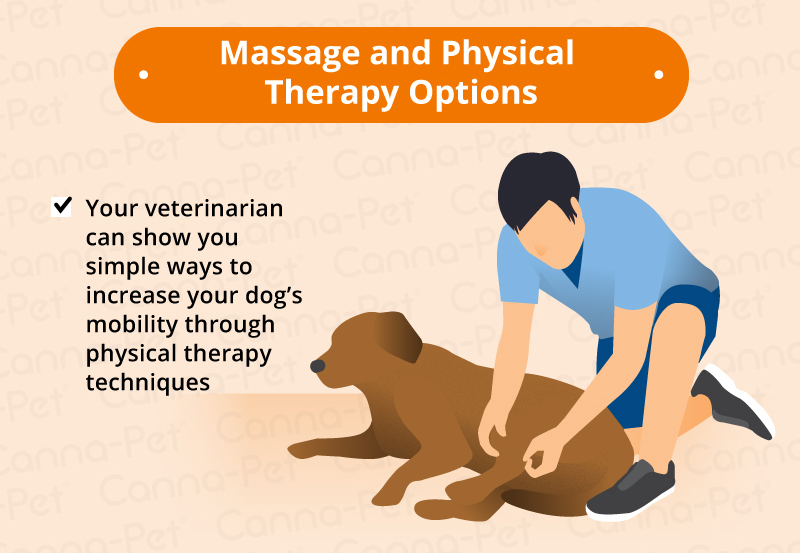
Make Your Dog’s Daily Routine as Pain-Free as Possible
Since your dog’s osteoarthritis causes joint pain and discomfort, making his daily routine as pain-free as possible is one of the easiest ways to protect him from further physical agitation. Simple tasks such as going up and down the stairs can be difficult, so buying a ready-to-install ramp for outdoor usage or for climbing into the car can ease simple tasks on a day-to-day basis.
Another simple tip: keep everything at the appropriate level. For larger dogs, elevating their food and water bowls allows them to eat more comfortably, especially if they’re showing signs of stiffness in the back or neck area.
It’s always essential to discuss treatment options with your veterinarian to determine the best course of action when managing your dog’s osteoarthritis conditions. Never administer any type of medication without first consulting your vet, even if it’s a seemingly innocuous over-the-counter treatment.
By providing a carefully researched plan of managed care, including weight management, proper diet, appropriate exercises and supplemental integrative therapies, your beloved pooch can live a long and healthy life with a minimal amount of pain and discomfort.
